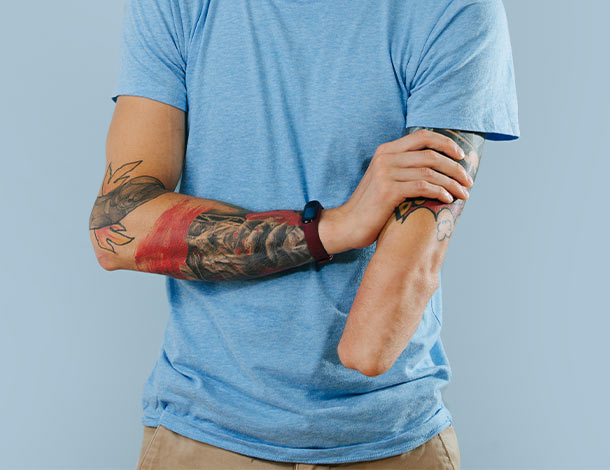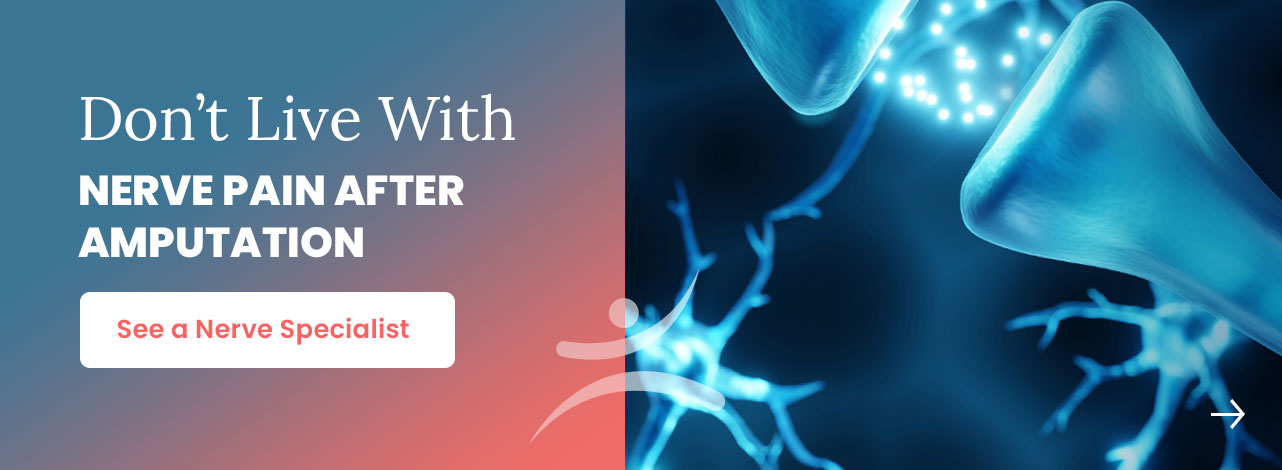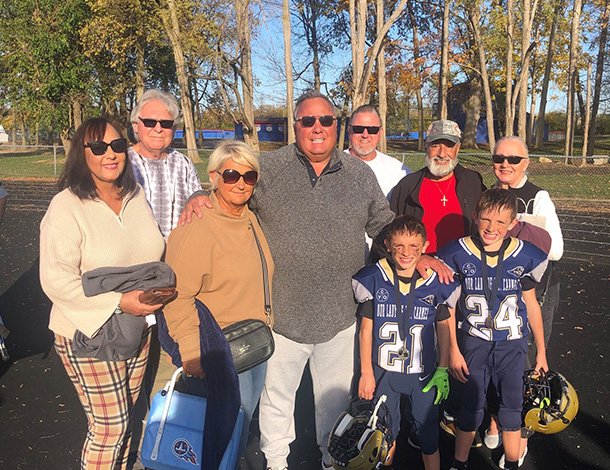Phantom Pain and Residual Limb Pain After Amputation Questions Answered

In this post, IHTSC nerve pain specialists answer frequently asked questions about phantom pain and residual limb pain after amputation. They cover common causes and treatments, as well as explain the benefits of the Nerve Injury & Limb Pain Program’s team-based approach to care.
How Can You Make Phantom Pain Go Away?
Surgeon Kathryn Peck, MD talks about phantom limb pain and treatment options available to help make the pain go away.
What Is Phantom Pain?
Phantom pain is something that 80 percent of people who have experienced an amputation feel after the amputation. It can range from anything from pain like a burning sensation to the feeling of either your fingers or toes that are no longer there, but you feel that presence.
What Types of Treatments Are Available?
Things that we do to help treat this include conservative nonsurgical measures and operative measures.
Non-operative treatments include using multimodal medications such as:
- Beta-Blockers
- Pain Medication
- Anti-Inflammatories
- Anticonvulsant Therapies
All of these are used in conjunction with each other to help target different pain pathways. Some other measures that are not medication related but are not operative include:
- Tens Units
- Acupuncture
- Mirror Therapy
And other modalities help trick the brain into thinking that the limb is there, so it helps lessen that pain.
Operative measures include something called targeted muscle reinnervation, which is a surgical technique where we take one of the major nerves, such as the median nerve, and take a small regional sacrificable nerve branch that goes into a muscle and then bring those two nerve endings together, so that big nerve has an avenue through which to regenerate in hopes of avoiding a painful nerve ending or neuroma, as well as providing the brain with more normal signaling pathways.
It substantially cuts down on the phantom pain, and we can also put a muscular cuff around that nerve coaptation as well. That really does help with the phantom pain as a complement to using these other modalities.
Find Relief for Phantom Limb Pain
Our nerve pain experts would be happy to help you with your phantom pain if you would like to come and see us. We can further evaluate your condition to see if you’d be a candidate for any of these effective techniques and treatments.
What Is Residual Limb Pain?
Surgeon Jeffrey Greenberg MD, MS explains what is residual limb pain and how it can be treated.
Residual Limb Pain
Residual limb pain in amputees is common and affects a large percentage of patients following both upper and lower limb amputations.
How Is Residual Limb Pain Different From Phantom Pain?
Not every cause of residual limb pain is treatable, and the causes can come from multiple reasons. For example, phantom limb pain can occur after amputation and frequently is very difficult to eliminate.
However, there are sources of residual limb pain that are inappropriately attributed to untreatable phantom limb pain that are treatable by experienced nerve surgeons.
What Is a Neuroma?
A prime example of this is residual limb pain caused by peripheral nerve neuroma. A neuroma is a mass of disorganized nerve fibers and scars that can cause pain shock-like sensations.
Decreased use of the injured extremity and difficulty with prosthetics are where neuromas can develop at the end of nerves that are cut when an amputation occurs.
How Are Neuromas Treated?
Many symptomatic neuromas can be successfully treated using contemporary nerve reconstruction techniques.
How Can a Specialist Help With Post-Amputation Residual Limb Pain?
The surgeons at the Indiana Hand to Shoulder Center that participate in the Nerve Injury And Limb Pain Program are experts in evaluating, diagnosing, and treating residual limb pain problems.
A consultation with our group is recommended if you are suffering from residual limb pain. The consultation will include a detailed evaluation by our group of experts to determine the cause of your problem.
Following your evaluation the group will formulate and review individualized treatment recommendations based on your specific situation and problem.
Post-Amputation Peripheral Nerve Pain
Dr. Brandon Smetana talks about post-amputation peripheral nerve pain and the benefits of having team-based care.
Why Did You Start the IHTSC Nerve Clinic?
The nerve injury and limb pain program was generated to directly serve a patient population that can be overlooked in Indiana: those with nerve injuries and nerve pain.
While the Indiana Hand to Shoulder Center has been providing expert-level care to patients with upper extremity nerve disorders for 50 years, our profession’s understanding of injury patterns, treatment options, and management strategies have evolved over time.
Fewer providers in the community are trained to recognize and treat nerve disorders in the limbs, and patients can be left with few treatment options.
We felt as though patients with upper and lower extremity nerve, brachial plexus, and spinal cord injuries, as well as amputees who have already developed or are at risk of developing limb pain and phantom limb sensations, were underserved in our community.
Our goal was to develop and promote a multidisciplinary team to care for patients with these complex upper and lower extremity nerve injuries to better serve Hoosiers and the Midwest community.
Who Does the IHTSC Nerve Clinic Serve?
The nerve injury and limb pain program serves patients with both upper and lower extremity nerve injuries. We also treat patients with complex nerve injuries involving the brachial plexus and spinal cord in hopes of improving upper extremity function
Finally, we care for patients with both upper and lower extremity amputations in hopes of minimizing post-amputation limb pain and hypersensitivity, narcotic use, and phantom limb sensations as well as assisting with optimizing prosthetic fit and functionality.
Why Should a Patient Choose Team-Based Care for Post-Amputation Peripheral Nerve Pain?
It became evident in our independent practices that a team-based approach would best serve patients with complex nerve injury patterns.
From the physician’s perspective, each of us can converse with (and examine) the patient to define the problems and treatment goals better. Second, third, fourth, and sometimes fifth opinions are generated at each office visit as the team-based model allows us to collaborate to combine our collective knowledge and expertise to generate an ideal treatment plan for patients depending on their individual goals.
The collaborative model carries over into the operating room where we can assist each other in performing these highly technical surgical interventions to ensure the highest level of surgical care is delivered.
Through partnering and integrating other services such as EMG/NCS diagnostics the nerve injury and limb pain program at the Indiana Hand to Shoulder Center strives to provide complete care to those who may be affected by both physical and psychological limitations after their injury.
We partner with regional prosthetic, physical therapy, psychiatric, and pain specialists to help optimize care and functionality for our patients.
What Are Different Types of Post-Amputation Pain?
Amputees can experience debilitating pain that may lead to reliance on or addiction to strong pain medicines, can limit their use of a prosthetic, hindering overall functionality, and cause significant psychological distress.
Post-amputation pain may be felt at a single spot where a neuroma or painful nerve ending has formed and may “zing” up the residual limb or down to where the amputated limb was located. This can cause difficulty when touching this spot on the arm or leg and even may cause hypersensitivity where it is even difficult to lightly touch the area such as pulling the sheets over the area when getting into bed.
Phantom limb pain and sensations can occur when the brain believes the limb is still there. This leads amputees to feel a sensation of burning, tingling, numbness, and even pain in what was the amputated part, even though it is no longer there.
When Should You See a Team of Specialists About Your Post-Amputation Peripheral Nerve Pain?
Post-amputation pain and phantom limb sensations can be debilitating. They can cause significant physical and psychological distress, limit the use of prosthetics, and impede a patient’s return to a functioning member of society.
Treatment options for injured nerves during an amputation are successful at diminishing pain and phantom limb sensations, improving prosthetic use, and diminishing reliance on narcotics at any time point for amputees with post-amputation nerve pain.
However, treatments are more effective if done at the same time or soon after the amputation occurs. We recommend amputees seek care as soon as possible to improve the likelihood of a successful outcome.
Schedule an Appointment With an IHTSC Nerve Specialist
Learn More About IHTSC Nerve Injury & Limb Pain Program
Get Relief for Pain After Amputation
If you are suffering from nerve pain or injuries after amputation, we invite you to come to our clinic to see a nerve specialist. The surgeons at IHTSC’s Nerve Clinic will evaluate and determine if you are a candidate for any of their nerve pain techniques.

Disclaimer: The materials on this website have been prepared for informational purposes only and do not constitute advice. You should not act or rely upon any medical information on this website without a physician’s advice. The information contained within this website is not intended to serve as a substitution for a thorough examination from a qualified healthcare provider. The display of this information is not intended to create a health care provider-patient relationship between the Indiana Hand to Shoulder Center and you.



